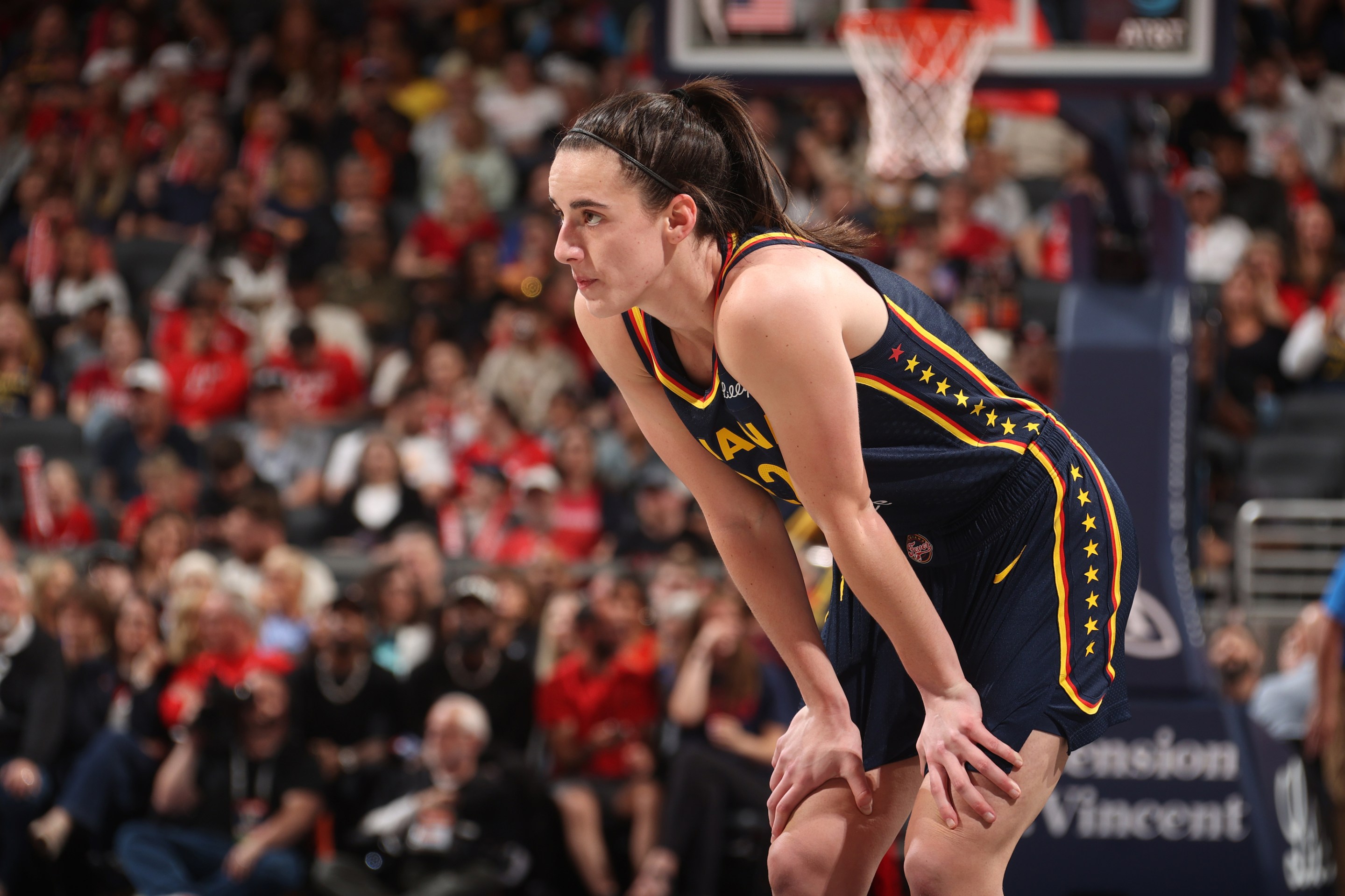INDIANAPOLIS — In 49 states, it’s just basketball … and in this state, it’s also just basketball. That's what Caitlin Clark might tell you, anyway. Since joining the Indiana Fever, she’s taken great pains to put herself in perspective like that. As she sees it, very little about her situation is uncommon or strange.
An hour and a half before her home debut Thursday night against the New York Liberty, a room of reporters is insisting on Clark’s singularity, to no avail. The quick turnaround from the college season to the WNBA season must be a whirlwind, right? “It’s been the same [the] whole time we’ve had the league. It’s been the same for every other rookie that’s come into this league,” she says. The Fever play their first seven games in 12 days, a steeper learning curve than the three or four practices between games in college. “But at the same time, that’s the same scenario for every other team.” Yes, talking to the media three times a day can be tiring, but “this is something we all have to do, and other players around the league are doing it too, so it’s the same for everybody.” Really, when you think about it, being Caitlin Clark is exactly like being any other kind of person. “Just like all of you and your jobs and your responsibilities—it goes the same for me.”
See? It's just like how thousands of people fill an arena to watch you work, and how they append “Effect” and “-onomics” to your name. And how they consider everything you do a referendum on your industry. And how you might be, as a TV reporter near me muses, the biggest name in town since Peyton Manning. It’s just like that. To see a young woman carry out her job responsibilities, I’m joined on Thursday night by Rick Carlisle, Myles Turner, the newly retired Lisa Bluder, 50-odd media members, some 17,000 fans, and the unmistakably sunburnt arms of Pat McAfee, protruding from a Fever muscle tank as the former punter sits courtside.
Women’s basketball fandom has accustomed me to the feeling of intrusion. In its early days, the league caught flak for playing “when the boys weren’t using the gym.” A still-familiar sight at WNBA games is a court bearing another team’s name and logo; women, after all, should be grateful for what they have. But this is the Fever’s gym. The crowd wears Fever gear. They mill about Pennsylvania Street in brand-new Caitlin Clark jerseys hours before the game. They form long, snaking lines to buy more at the team store. The following night, I return to the arena, this time to watch a men’s game with higher stakes. The triangular banners outside have been replaced by new faces—Aliyah Boston swapped for Tyrese Haliburton, Kelsey Mitchell for Pascal Siakam—but inside, the stairs from the entryway to the main concourse are still striped in Fever red.
The Fever’s gym is designed to evoke the state’s basketball tradition, and the crowd, searching for an old feeling, lives and dies with the rookie star. Clark has cultivated that hold-your-breath reputation in the last four years, but the fans are still waiting for the held breath to be punctuated by something. The Liberty assign her to Betnijah Laney-Hamilton, whose success story incidentally begins with being cut by the Indiana Fever. The All-Defensive guard forces Clark off the ball more, and the few shots she gets off aren't going in. After her fourth three-point miss of the night, she puts her arms atop her head, maybe in horror, or possibly to keep it from exploding.
Clark has always worn her games on her face and in her shoulders. Her head becomes a prop, smacked after a bad pass, hidden in her hands when a shot rims out. Two minutes into the second quarter, having scored just two points, she checks out and thwacks her chair with a towel. Some camera operators behind me get to talking. “It’s sort of like—I know this isn’t a good comparison,” one says, before soldiering on anyway, “Peyton Manning throwing the most interceptions as a rookie.”
Basketball is chaotic to cover in person; it really does help to have a crew of announcers and producers weaving together the game’s constituent parts. Somewhere between parsing Clark’s body language on the bench, making notes on the early-season rotations, and wondering if that's Jim Boylen next to Rick Carlisle (it is), I lose track of the score. I look up and the Liberty's lead has ballooned to 23.
By the fourth quarter, McAfee is wondering whether the Liberty are the “greatest team assembled of all time.” He films his daily show for ESPN nearby, in a studio called “the Thunderdome,” and Clark has sent him on a women’s basketball educational journey that is almost charming in its vacuity. “Smooth,” he can only say, to describe DeWanna Bonner the morning after Clark's first game against the Sun. “We’re talking about—there’s some bucket-getters on that other team that I have never heard of.” Later on that day’s show, he and his pals mull a Fever coaching change. One of McAfee's producers proposes a Gruden-style trade for Aces head coach Becky Hammon. Kids say the darndest things.
McAfee's mindless riffing contains a kernel of truth: Clark makes basketball look difficult tonight, and Breanna Stewart makes it look easy. She trades on that uncanny turnaround jumper; limbs akimbo, but it still works. At her best, in the form she has left curiously uninhabited for several months, Stewart turns her opponents into playground children, and it is almost relieving to see her playing like this again, as if she had recognized the dizzying change afoot in women’s basketball and decided to be a bulwark against it, a champion of the familiar.
The Indianapolis crowd also craves the version of Clark they're familiar with, the one who blows by defenders across halfcourt and pulls up from the logo. The only entertainment at the Fever logo comes from Frisbee dogs, writhing across it mid-air during the halftime show. Transition offense is nigh incompatible with the defense the Fever are playing now, but on the few occasions the Fever manage a defensive stop, the Clark they know reappears, and the arena starts to buzz a little again. She checks out of the game with nine points, seven rebounds, six assists, and three turnovers, seven fewer than in her season opener.
Clark, as a media phenomenon, forces three species into a single habitat: women’s basketball reporters, some Iowa-based writers and photographers still following her around, and members of the Indiana sports scene she has recently tumbled into. (Not everyone has handled the new arrival so well: An Indianapolis Star columnist responsible for a painfully awkward exchange at Clark’s introductory press conference has since been banned from covering her.) After the game, waiting for the autopsy from players and head coach Christie Sides, the women’s basketball coterie lets the rest of the press room in on a leaguewide joke: To begin the season, the Fever play the WNBA’s three best teams in the span of two weeks, the Sun and Liberty twice each. Two games into her pro career, Clark has faced the league’s reigning MVP, and the second-place finisher. She’ll play the Liberty again on Saturday. A local columnist in the front row offers, wearily, that Peyton Manning set the rookie interception record.
This, I suppose, is another means of perspective: the journalist’s way of plotting everything along the arc of greatness. The next morning, over slices of cinnamon toast at a downtown breakfast spot, I read through my notes and think back to the only other time I’ve seen Clark finish a game in the single digits. She was a freshman playing Northwestern. The Wildcats ran a defense called “the Blizzard,” an intricate matchup zone meant to torture guards, especially inexperienced ones. The next time she played Northwestern, later that January, she put up 23 points. In the meeting after that, in her sophomore year, she scored 30. On Saturday, in front of another sold-out crowd in New York, the Fever will lose again, 91-80, but Clark will start to look more confident—the threes will go in, she’ll glide downhill—and she’ll score 22. As I finish breakfast and leave, I find myself face-first with a 150-foot Caitlin Clark ad pinned on the side of a building.
There is almost nothing to like for the Fever in their home debut. Aliyah Boston struggles against Jonquel Jones. NaLyssa Smith misses some bunnies. Indiana loses, 102-66. But there is a moment in the third quarter, when it looks like a young team has begun to figure the league out. With Laney-Hamilton on the bench, Clark can stay on-ball more. She leads a 7-0 run—it all begins with a stepback three—and breathes some life into the arena. The flicker won’t last, but it’s a proof of concept.
Back in the interview room after the game, someone else has done a Google search ... for Peyton Manning’s rookie stats; he set the interception record. The door finally opens, and through it come Boston and Katie Lou Samuelson, ready to dissect the blowout loss. “We will give the crowd more energy than we gave tonight. We can give them as much as they’re giving to us,” Samuelson says. The two leave, and the reporter in front of me also leaves, in a huff, realizing the person she came here to see won’t be made available to the press tonight after all. Caitlin Clark has had a long day, and it’s finally over.






